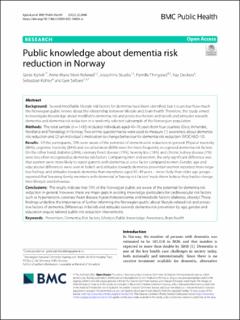| dc.description.abstract | Background: Several modifiable lifestyle risk factors for dementia have been identified, but it is unclear how much the Norwegian public knows about the relationship between lifestyle and brain health. Therefore, this study aimed to investigate knowledge about modifiable dementia risk and protective factors and beliefs and attitudes towards dementia and dementia risk reduction in a randomly selected subsample of the Norwegian population. Methods: The total sample (n = 1435) included individuals aged 40–70 years from four counties (Oslo, Innlandet, Nordland and Trøndelag) in Norway. Two online questionnaires were used to measure (1) awareness about dementia risk reduction and (2) an individual`s motivation to change behaviour for dementia risk reduction (MOCHAD-10). Results: Of the participants, 70% were aware of the potential of dementia risk reduction in general. Physical inactivity (86%), cognitive inactivity (84%) and social isolation (80%) were the most frequently recognised dementia risk factors. On the other hand, diabetes (26%), coronary heart disease (19%), hearing loss (18%) and chronic kidney disease (7%) were less often recognised as dementia risk factors. Comparing men and women, the only significant difference was that women were more likely to report parents with dementia as a risk factor compared to men. Gender, age and educational differences were seen in beliefs and attitudes towards dementia prevention:women reported more negative feelings and attitudes towards dementia than men;those aged 40–49 years – more likely than older age groups – reported that ‘knowing family members with dementia’ or ‘having risk factors’ made them believe they had to change their lifestyle and behaviour. Conclusions: The results indicate that 70% of the Norwegian public are aware of the potential for dementia risk reduction in general. However, there are major gaps in existing knowledge, particularly for cardiovascular risk factors such as hypertension, coronary heart disease, hypercholesterolemia and metabolic factors (diabetes, obesity). These findings underline the importance of further informing the Norwegian public about lifestyle-related risk and protective factors of dementia. Differences in beliefs and attitudes towards dementia risk prevention by age, gender and education require tailored public risk reduction interventions. | en_US |

